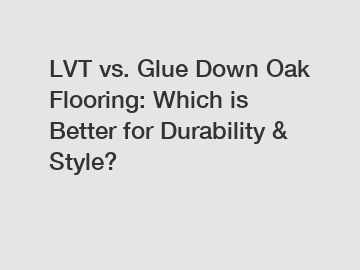LVT vs. Glue Down Oak Flooring: Which is Better for Durability & Style?
LVT vs. Glue Down Oak Flooring: Which is Better for Durability & Style?
When it comes to choosing flooring options for your home, durability and style are two essential factors to consider. Among the various flooring choices available, LVT (Luxury Vinyl Tile) and glue-down oak flooring are popular options. Both have their own set of advantages and disadvantages, making it important to understand the key differences before making a decision.
Durability is a crucial aspect to consider when selecting flooring materials, particularly in high-traffic areas of the home. LVT is known for its exceptional durability, making it a popular choice for commercial spaces as well. It is designed to withstand heavy foot traffic, resist scratches, indentation, and moisture damage. The wear layer in LVT provides an extra layer of protection, ensuring the flooring's longevity. This durability factor contributes to its suitability for families with children or pets.

On the other hand, glue-down oak flooring offers excellent durability as well. Oak is a hardwood that naturally resists wear and tear, making it a great option for high-traffic areas. When properly installed and maintained, glue-down oak flooring can last for decades. It can withstand heavy furniture, foot traffic, and scratches, maintaining its aesthetic appeal over time.
While both LVT and glue-down oak flooring offer durability, aesthetic appeal is another crucial consideration. LVT comes in a wide variety of designs and patterns, including wood, stone, and tile looks. Advances in technology have made it difficult to distinguish LVT from real hardwood flooring. This versatility allows homeowners to achieve their desired style without compromising on durability.
On the other hand, glue-down oak flooring offers the timeless beauty of natural hardwood. The rich grains and textures of oak bring warmth and sophistication to any space. With its natural variations, no two glue-down oak floors are identical, making it a unique and visually appealing choice.
In terms of the application process, LVT is a floating floor type, which means it is not fully attached to the subfloor. This makes installation quick and easy, allowing homeowners to enjoy their new flooring sooner. Additionally, LVT can be installed over existing floors, saving time and money on the removal process.
Glue-down oak flooring, as the name suggests, requires adhesives to secure the planks onto the subfloor. While the installation process may take longer, the result is a firmly bonded floor that feels solid underfoot. This installation method is particularly beneficial for areas prone to moisture, as it minimizes the risk of water seeping between the planks.
In conclusion, both LVT and glue-down oak flooring offer durability and style, but the choice ultimately depends on personal preferences and specific requirements. LVT provides exceptional durability and a wide range of design options, while glue-down oak flooring offers the timeless beauty of natural hardwood. Understanding the differences between the two allows homeowners to make an informed decision that best suits their needs. Whether durability, style, installation ease, or unique aesthetics, both options offer a long-lasting solution for any home.
If you are looking for more details, kindly visit spc rigid core vinyl flooring manufacturer, homogeneous flooring manufacturer, LVP flooring flooring supplier.
114
0
0


Comments
All Comments (0)